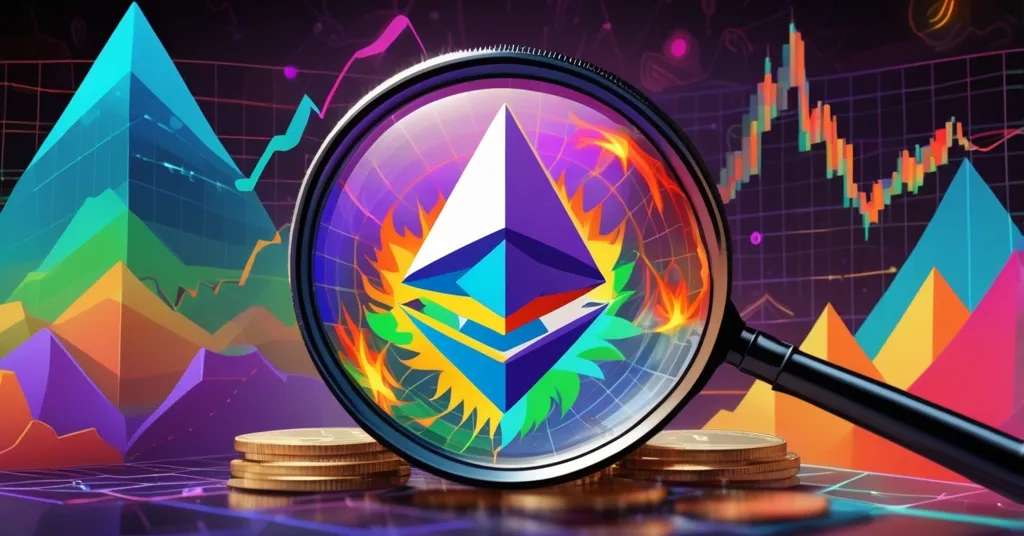Ethereum’s Investment Value Debated: Is ETH Dead or Just Evolving?

Ethereum’s Investment Prospects: A Heated Discussion
Quinn Thompson, the Chief Investment Officer at Lekker Capital, has sparked a heated discussion within the cryptocurrency community by declaring Ethereum (ETH) “completely dead” as an investment. This bold statement has drawn responses from industry leaders, shedding light on Ethereum’s valuation and future potential.
- Ethereum’s investment value debated
- Declining metrics versus network utility
- Impact of Layer 2 solutions
- Deflationary token burning mechanism
- Broader trends in cryptocurrency market
Thompson’s argument centers around what he sees as Ethereum’s declining metrics: transaction activity, user growth, and fees/revenues. He argues that these factors do not justify Ethereum’s $225 billion market cap, especially with Ethereum trading at $1,793 at the time of his statement.
“Make no mistake, ETH as an investment is completely dead,” Thompson declared. “A $225 billion market cap network that is seeing declines in transaction activity, user growth, and fees/revenues. There is no investment case here. As a network with utility? Yes. As an investment? Absolutely not.”
Not everyone shares Thompson’s pessimistic view. Nic Carter, a partner at Castle Island Ventures and co-founder of Coinmetrics, attributes Ethereum’s valuation challenges to the impact of Layer 2 scaling solutions. For those unfamiliar, Layer 2 solutions are secondary frameworks built on top of the main Ethereum blockchain (Layer 1) to enhance scalability and reduce transaction fees. Carter argues,
“The #1 cause of this is greedy eth L2s siphoning value from the L1 and the social consensus that excess token creation was A-OK. Eth was buried in an avalanche of its own tokens. Died by its own hand.”
Omid Malekan, a professor at Columbia Business School and a noted crypto expert, offers a different perspective. He defends the necessity of Layer 2 solutions, stating,
“L2s are the only viable way to scale any blockchain. Whether their tokens capture value or not is a separate question. But it can’t be that L2s ‘siphoned value from ETH’ yet didn’t capture value themselves. Security is not free.”
Malekan’s point is that while Layer 2 solutions may divert some value from the main Ethereum network, they are essential for the blockchain’s growth and scalability.
Scott Johnsson, General Partner at VB Capital, challenges Thompson’s oil network analogy, highlighting Ethereum’s unique deflationary token burning mechanism. In simple terms, token burning means permanently removing a portion of the total supply of ETH from circulation, which can potentially increase the value of the remaining tokens.
“I don’t disagree with your directional call, but I think this analogy falls flat,” Johnsson countered. “ETH ‘production’ is inversely correlated with usage, which is certainly not the case with oil. So as oil price increases, there is a demand response and a supply response. With ETH, it’s limited to the demand response. If ETH consumption looks like barrel consumption, then the price of ETH is far more likely to accrue value.”
The debate reflects broader concerns within the cryptocurrency community about Ethereum’s scalability and its ability to maintain its market position amidst fierce competition. Ethereum’s ongoing efforts to improve its network through Layer 2 solutions and its transition to proof of stake (a more energy-efficient consensus mechanism where validators are chosen to create new blocks based on the number of coins they hold and are willing to ‘stake’ as collateral) have been pivotal, yet controversial, moves in its evolution.
While Thompson’s bearish stance on Ethereum as an investment has sparked controversy, it also underscores the importance of critically evaluating the metrics that underpin a cryptocurrency’s value. The discussion around Ethereum’s investment potential is far from over, with each side presenting compelling arguments that reflect the dynamic and often contentious nature of the crypto market.
As we navigate this complex landscape, it’s crucial to consider both the optimistic and realistic perspectives on Ethereum’s future. While some see its utility and scalability efforts as a path to renewed growth, others remain skeptical of its ability to justify its current market valuation. The truth, as always, lies somewhere in between, shaped by the ongoing developments and debates within the crypto community.
Let’s break this down with some key questions:
- Is Ethereum losing its value as an investment?
Quinn Thompson argues that Ethereum is “completely dead” as an investment due to declining metrics and an unsustainable market cap. However, this view is contested by others who see potential in Ethereum’s utility and scalability efforts.
- What impact do Layer 2 solutions have on Ethereum’s token economics?
Layer 2 solutions are designed to enhance Ethereum’s scalability but have been criticized for potentially siphoning value away from the main Ethereum network. Omid Malekan argues they are essential for growth, while Nic Carter sees them as detrimental to Ethereum’s valuation.
- How does Ethereum’s deflationary token burning mechanism influence its investment potential?
Scott Johnsson highlights that Ethereum’s token burning mechanism, which reduces the supply of ETH as usage increases, could potentially drive up its value. This contrasts with Thompson’s view that network effects are not sufficiently monetized to justify Ethereum’s current valuation.
- What are the key factors contributing to Ethereum’s market valuation?
The discussion highlights several factors, including transaction activity, user growth, fees/revenues, and the impact of Layer 2 solutions. These elements are debated as either supporting or undermining Ethereum’s investment case.
- How does the debate over Ethereum’s investment potential reflect broader trends in the cryptocurrency market?
The debate reflects ongoing concerns about blockchain scalability, token economics, and the sustainability of market valuations in the cryptocurrency sector. It highlights the tension between technological innovation and investment viability.



